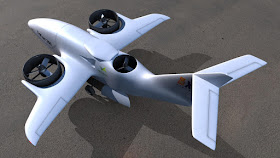DAYTONA BEACH, FL -- Recognizing the need for fast, economical, point-to-point cargo and logistics transportation, VerdeGo Aero in Daytona Beach, FL and XTI Aircraft Company in Denver, CO have partnered together on the TriFan 200 program. XTI Aircraft, a leader in next-generation VTOL aircraft, is developing the TriFan 200, a configuration similar to its larger TriFan 600 VTOL passenger aircraft already under development. VerdeGo Aero is applying its high-efficiency, low-emissions diesel (Jet-A) hybrid powertrain to enable the TriFan 200 to offer operators outstanding operating economics.
When the program reaches commercial development and certification, XTI’s TriFan 200 Vertical Takeoff and Landing (VTOL) aircraft will be an unmanned autonomous aircraft capable of transporting 500 lbs of cargo on missions of more than 200 nautical miles. The TriFan 200 will enable express logistics companies to rapidly address “miles 1 to 20” when shipping urgent cargo by rapidly connecting global air cargo hubs with distribution points throughout major cities. Surface transportation in highly congested global cities currently takes up to 90 to 120 minutes for urgent cargo to travel between air cargo hubs at major airports and the city centers. The XTI TriFan 200 will enable significant time to be removed from both ends of the journey, allowing later pickup times and earlier deliveries. In addition to express shipping, the TriFan 200 is also applicable to longer-range transportation in remote locations without infrastructure, including military logistics missions.
“The TriFan 200 aircraft will open up a significant new market for XTI to address the needs of cargo and logistics operators globally. We are excited to be partnered with VerdeGo to leverage their experience with hybrid powertrains combined with our experience from the TriFan 600 program to create an efficient, economical, profitable VTOL aircraft for fleet operators worldwide,” said Robert LaBelle, CEO, XTI Aircraft.
VerdeGo Aero’s diesel (Jet-A) hybrid systems offer the lowest operating cost and largest mission flexibility for next-generation electric aircraft. Combining VerdeGo’s highly efficient 180KW generator with VerdeGo’s high-power battery pack, enables aircraft like the TriFan 200 to operate profitably for fleet operators. The high efficiency of VerdeGo’s diesel hybrid generators is instrumental in reducing emissions and fuel burn by 35% when compared to conventional turbine powertrains, while also reducing overall direct operating cost by 40%. Utilizing globally available Jet-A fuel means no new infrastructure is necessary, and aircraft utilizing VerdeGo’s hybrid systems are ready for the biofuel Jet-A substitutes now under development.
“XTI’s TriFan 200 is an outstanding application for VerdeGo’s hybrid powertrain systems and we are excited to support XTI as an early customer. XTI’s goals to provide its customers with reliable, high-performance cargo aircraft are ideally matched with the efficiency and low operating cost of VerdeGo’s diesel hybrid powertrains,” said Eric Bartsch, CEO and Co-founder of VerdeGo Aero.
XTI Aircraft Company is a privately owned aircraft OEM based near Denver. XTI is guided by a leadership team with decades of experience, a deep well of expertise, and success bringing new aircraft to market. XTI is founded on a culture of customer-focused problem solving to meet the evolving needs of modern travelers.
VerdeGo Aero, founded in 2017, is a leader in propulsion technologies for the next generation of aircraft. VerdeGo’s electric powertrain technologies enable its customers to create more competitive aircraft by leveraging VerdeGo Aero’s expertise in hybrid-electric propulsion and battery-electric aircraft systems. VerdeGo Aero has successfully performed its initial series of tests to validate their hybrid-electric powertrain Iron Bird test system at power output levels above 150KW. The VerdeGo hybrid generator can be combined with battery packs to enable peak power output up to 0.5MW and modular twin generator systems can be stacked for 360KW continuous and 1MW peak output.






No hay comentarios:
Publicar un comentario